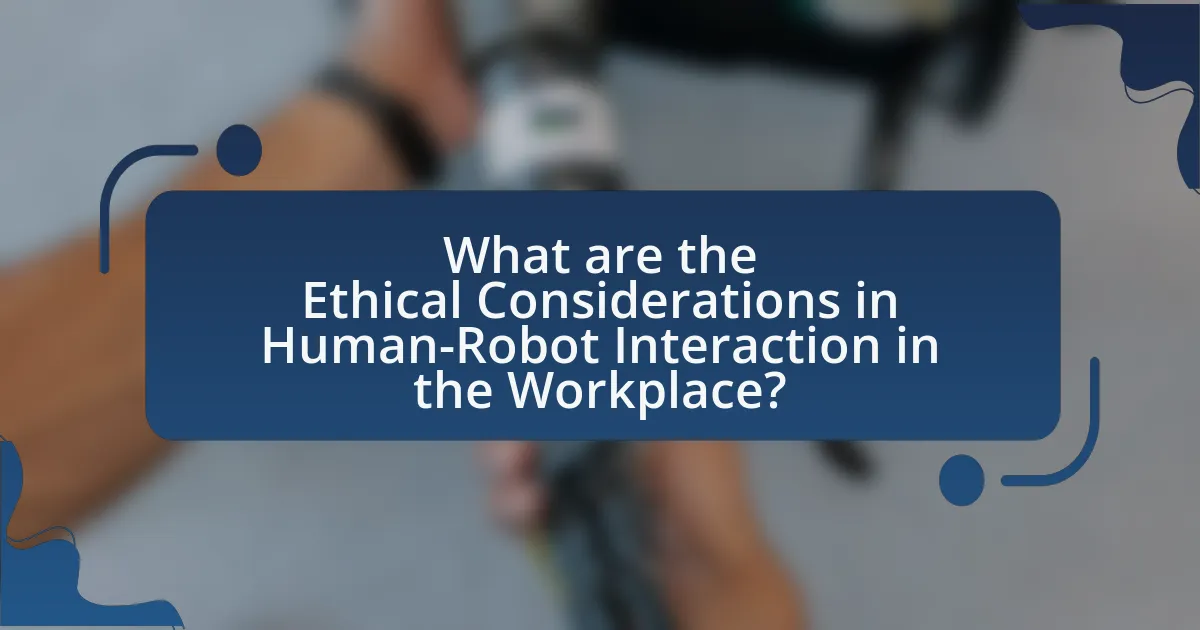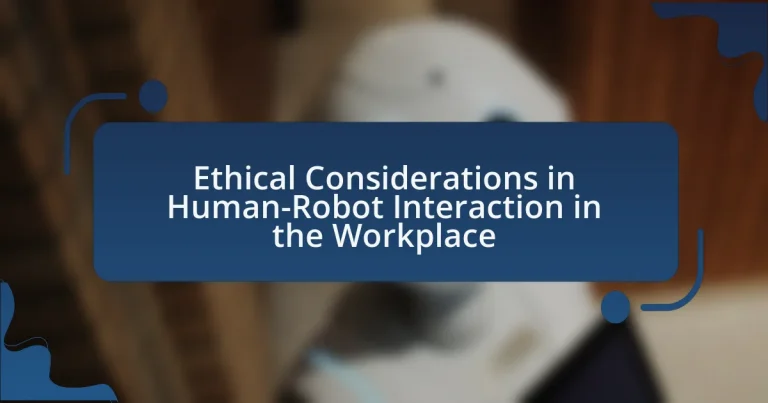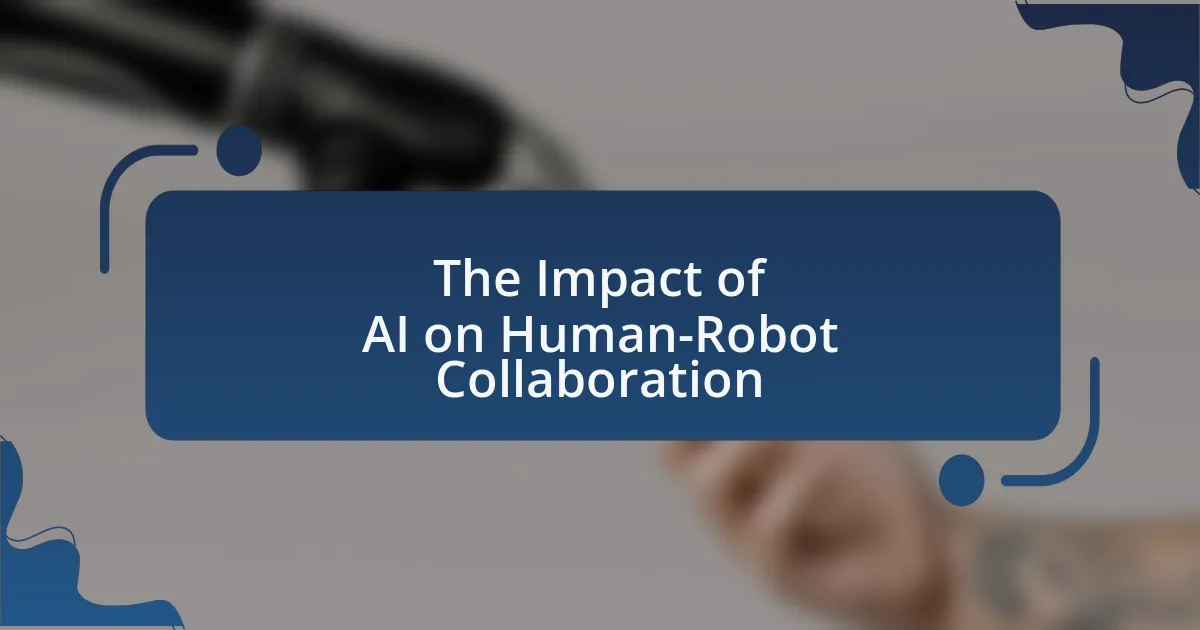The article focuses on ethical considerations in human-robot interaction in the workplace, addressing critical issues such as autonomy, privacy, job displacement, and accountability. It highlights the importance of ethical frameworks to ensure safety, trust, and fairness in workplace environments, while also discussing the ethical dilemmas that arise from integrating robots, including the impact on employee morale and trust. Key ethical principles relevant to this interaction, such as beneficence, non-maleficence, and transparency, are examined, along with the influence of cultural differences on ethical perceptions. The article emphasizes the need for organizations to implement ethical guidelines and training programs to navigate these complexities effectively.

What are the Ethical Considerations in Human-Robot Interaction in the Workplace?
Ethical considerations in human-robot interaction in the workplace include issues of autonomy, privacy, job displacement, and accountability. Autonomy concerns arise when robots make decisions that affect human workers, potentially undermining their agency. Privacy issues emerge as robots may collect sensitive data about employees, leading to surveillance concerns. Job displacement is a significant ethical dilemma, as automation can lead to unemployment or reduced job security for human workers. Accountability becomes complex when robots cause harm or make errors, raising questions about who is responsible—the employer, the robot manufacturer, or the robot itself. These considerations are critical for ensuring that the integration of robots in the workplace is done ethically and responsibly.
Why is it important to address ethics in Human-Robot Interaction?
Addressing ethics in Human-Robot Interaction is crucial to ensure safety, trust, and fairness in workplace environments. Ethical considerations guide the design and deployment of robots, influencing how they interact with humans and the potential impact on jobs and social dynamics. For instance, research by the IEEE Global Initiative on Ethics of Autonomous and Intelligent Systems emphasizes that ethical frameworks can prevent biases in algorithmic decision-making, thereby fostering equitable treatment among workers. Furthermore, ethical guidelines help mitigate risks associated with privacy violations and ensure that robots operate transparently, which is essential for building user trust and acceptance.
What ethical dilemmas arise from integrating robots in the workplace?
Integrating robots in the workplace raises several ethical dilemmas, primarily concerning job displacement, accountability, and privacy. Job displacement occurs as robots can replace human workers, leading to unemployment and economic inequality; for instance, a study by the McKinsey Global Institute estimates that up to 800 million jobs could be lost to automation by 2030. Accountability issues arise when robots make decisions that affect human lives, such as in healthcare or autonomous vehicles, creating ambiguity about who is responsible for errors or accidents. Privacy concerns also emerge as robots often collect data on employees, potentially infringing on personal privacy rights and leading to surveillance issues. These dilemmas necessitate careful consideration and regulation to balance technological advancement with ethical standards.
How do ethical considerations impact employee trust and morale?
Ethical considerations significantly impact employee trust and morale by fostering a sense of fairness and respect within the workplace. When organizations prioritize ethical practices, employees are more likely to feel valued and secure, which enhances their overall morale. Research indicates that companies with strong ethical standards experience higher employee engagement and lower turnover rates. For instance, a study by the Ethics & Compliance Initiative found that organizations with a positive ethical culture reported 30% higher employee morale compared to those with weaker ethical frameworks. This correlation demonstrates that ethical considerations are crucial for building trust and maintaining high morale among employees.
What are the key ethical principles relevant to Human-Robot Interaction?
The key ethical principles relevant to Human-Robot Interaction include autonomy, beneficence, non-maleficence, justice, and transparency. Autonomy emphasizes the importance of respecting human decision-making and agency in interactions with robots. Beneficence focuses on promoting the well-being of users, ensuring that robots enhance human capabilities and experiences. Non-maleficence requires that robots do not cause harm to individuals or society, while justice addresses fairness in access to robotic technologies and their benefits. Transparency involves clear communication about the capabilities and limitations of robots, fostering trust and understanding between humans and machines. These principles are essential for guiding the ethical development and deployment of robots in workplace settings, ensuring that they serve human interests responsibly and equitably.
How do autonomy and accountability play a role in ethical considerations?
Autonomy and accountability are crucial in ethical considerations as they define the boundaries of decision-making and responsibility in human-robot interactions. Autonomy allows robots to operate independently, making decisions based on programmed algorithms, which raises ethical questions about the extent of their decision-making power and the potential consequences of those decisions. Accountability ensures that there is a clear attribution of responsibility for actions taken by robots, particularly when those actions lead to harm or ethical dilemmas. For instance, if a robot malfunctions and causes injury, accountability determines whether the manufacturer, programmer, or user is responsible, thereby influencing ethical standards in design and deployment. This interplay between autonomy and accountability shapes the ethical framework guiding the integration of robots in the workplace, emphasizing the need for clear guidelines and regulations to address potential risks and moral implications.
What is the significance of transparency in Human-Robot Interaction?
Transparency in Human-Robot Interaction is significant because it fosters trust and understanding between humans and robots. When robots clearly communicate their intentions, capabilities, and limitations, users can make informed decisions about their interactions. Research indicates that transparency reduces anxiety and enhances user acceptance, as demonstrated in studies where participants reported higher satisfaction and trust levels when robots provided clear explanations of their actions (e.g., the study by Lee et al., 2017, published in the journal “Human-Robot Interaction”). This clarity is essential in workplace settings, where effective collaboration between humans and robots can lead to improved productivity and safety.
How do cultural differences influence ethical considerations in Human-Robot Interaction?
Cultural differences significantly influence ethical considerations in Human-Robot Interaction (HRI) by shaping perceptions of autonomy, trust, and responsibility. For instance, in collectivist cultures, individuals may prioritize group harmony and shared decision-making, leading to ethical frameworks that emphasize collaborative robot behavior. Conversely, in individualistic cultures, personal autonomy and individual rights may take precedence, resulting in ethical guidelines that focus on user control and personal data privacy. Research by Hofstede (1980) highlights these cultural dimensions, demonstrating how varying cultural values impact ethical expectations and interactions with technology. Thus, understanding these cultural nuances is essential for developing ethical HRI frameworks that are culturally sensitive and effective in diverse workplace environments.
What variations exist in ethical perceptions across different cultures?
Ethical perceptions vary significantly across cultures, influenced by factors such as religion, societal norms, and historical context. For instance, collectivist cultures, like those in East Asia, often prioritize group harmony and social responsibility, leading to ethical decisions that emphasize community welfare over individual rights. In contrast, individualistic cultures, such as those in the United States, tend to focus on personal autonomy and individual rights, resulting in ethical frameworks that prioritize personal freedom and self-expression. Research by Hofstede (1980) highlights these cultural dimensions, illustrating how values shape ethical perceptions and decision-making processes in different societies.
How can organizations navigate cultural differences in ethics?
Organizations can navigate cultural differences in ethics by implementing comprehensive training programs that emphasize cultural awareness and ethical standards. These programs should include case studies that illustrate ethical dilemmas across various cultures, enabling employees to understand diverse perspectives. Research indicates that organizations with strong cultural competence training report improved collaboration and reduced conflicts, as seen in a study by the Harvard Business Review, which found that culturally aware teams are 30% more effective in problem-solving. By fostering an inclusive environment that respects and integrates diverse ethical viewpoints, organizations can enhance their decision-making processes and promote a cohesive workplace culture.
What are the potential consequences of neglecting ethical considerations?
Neglecting ethical considerations in human-robot interaction in the workplace can lead to significant negative consequences, including harm to employee well-being, erosion of trust, and potential legal repercussions. When ethical guidelines are overlooked, employees may experience increased stress and anxiety due to concerns about job security and privacy, as evidenced by studies showing that workers are less satisfied and more fearful in environments lacking ethical oversight. Furthermore, the absence of ethical frameworks can result in a breakdown of trust between employees and management, which is critical for effective collaboration and productivity. Additionally, organizations may face legal challenges if they fail to comply with regulations regarding worker rights and safety, as highlighted by cases where companies have been penalized for unethical practices.
How can unethical Human-Robot Interaction lead to workplace conflicts?
Unethical Human-Robot Interaction can lead to workplace conflicts by creating mistrust and resentment among employees. When robots are programmed to prioritize efficiency over ethical considerations, they may undermine human workers’ roles, leading to feelings of job insecurity and devaluation. For instance, if a robot is designed to monitor employee performance without transparency, it can foster an environment of suspicion, where workers feel they are being unfairly evaluated. Research indicates that such dynamics can result in decreased morale and increased turnover rates, as employees may feel compelled to leave a workplace that does not respect their contributions or privacy.
What are the long-term implications for organizations ignoring ethics?
Organizations that ignore ethics face significant long-term implications, including reputational damage, legal consequences, and decreased employee morale. Reputational damage can lead to loss of customer trust and loyalty, as seen in cases like Enron and Volkswagen, where unethical practices resulted in public backlash and long-lasting brand harm. Legal consequences may arise from regulatory penalties and lawsuits, which can financially cripple organizations; for instance, the fines imposed on Wells Fargo for unethical sales practices amounted to billions. Additionally, ignoring ethics can lead to decreased employee morale and higher turnover rates, as employees are less likely to remain with organizations that do not align with their values, ultimately affecting productivity and innovation.
How can organizations implement ethical guidelines for Human-Robot Interaction?
Organizations can implement ethical guidelines for Human-Robot Interaction by establishing clear policies that prioritize safety, transparency, and accountability. These guidelines should include protocols for assessing risks associated with robot deployment, ensuring that robots operate within defined ethical boundaries, and providing training for employees on interacting with robots. For instance, the IEEE Global Initiative on Ethics of Autonomous and Intelligent Systems offers a framework that emphasizes the importance of human oversight and ethical considerations in robotic systems. By adhering to such established frameworks, organizations can ensure that their interactions with robots are conducted ethically and responsibly.
What frameworks exist for establishing ethical standards in robotics?
Several frameworks exist for establishing ethical standards in robotics, including the IEEE Global Initiative on Ethics of Autonomous and Intelligent Systems, the Asilomar AI Principles, and the EU’s Ethics Guidelines for Trustworthy AI. The IEEE framework focuses on ensuring that technology aligns with human values and promotes ethical considerations in design and implementation. The Asilomar AI Principles emphasize safety, transparency, and accountability in AI development. The EU guidelines outline key requirements for AI systems, such as human oversight, technical robustness, and privacy. These frameworks collectively aim to guide the responsible development and deployment of robotic systems in various contexts, including workplaces.
How can training programs enhance ethical awareness among employees?
Training programs can enhance ethical awareness among employees by providing structured education on ethical standards and dilemmas relevant to their roles. These programs often include case studies, role-playing scenarios, and discussions that encourage employees to think critically about ethical issues they may encounter, particularly in the context of human-robot interaction. Research indicates that organizations implementing comprehensive ethics training see a significant increase in employees’ ability to identify and address ethical concerns, with a study by the Ethics & Compliance Initiative showing that 70% of employees who received ethics training felt more confident in making ethical decisions. This structured approach not only informs employees about company policies but also fosters a culture of ethical behavior, ultimately leading to improved decision-making and accountability in the workplace.
What best practices can organizations adopt for ethical Human-Robot Interaction?
Organizations can adopt several best practices for ethical Human-Robot Interaction (HRI) by prioritizing transparency, user consent, and accountability. Transparency involves clearly communicating the capabilities and limitations of robots to users, ensuring that individuals understand how robots will interact with them. User consent is essential; organizations should obtain informed consent from employees before deploying robots in the workplace, allowing them to opt-out if they feel uncomfortable. Accountability requires establishing clear guidelines for robot behavior and ensuring that there are mechanisms in place to address any ethical concerns or malfunctions that arise during HRI. These practices are supported by research indicating that ethical HRI fosters trust and enhances collaboration between humans and robots, ultimately leading to more effective workplace integration.
How can organizations ensure ongoing evaluation of ethical practices?
Organizations can ensure ongoing evaluation of ethical practices by implementing regular audits and assessments of their ethical frameworks. These evaluations should include stakeholder feedback, compliance checks, and the integration of ethical guidelines into training programs. For instance, a study by the Ethics & Compliance Initiative found that organizations with robust ethics programs experience 50% fewer incidents of misconduct. By continuously monitoring and adapting their ethical practices based on these evaluations, organizations can maintain a culture of integrity and accountability in the workplace.
What role does employee feedback play in refining ethical guidelines?
Employee feedback is crucial in refining ethical guidelines as it provides insights into the real-world implications of those guidelines. By collecting and analyzing feedback from employees, organizations can identify gaps, inconsistencies, or areas of concern within existing ethical frameworks. For instance, a study by the Ethics & Compliance Initiative found that organizations with strong employee feedback mechanisms are 50% more likely to have effective ethical cultures. This data underscores the importance of integrating employee perspectives to ensure that ethical guidelines are not only theoretically sound but also practically applicable in the context of human-robot interaction in the workplace.





